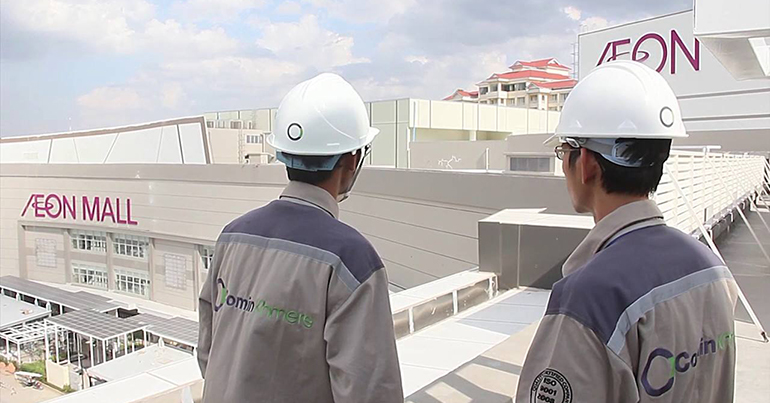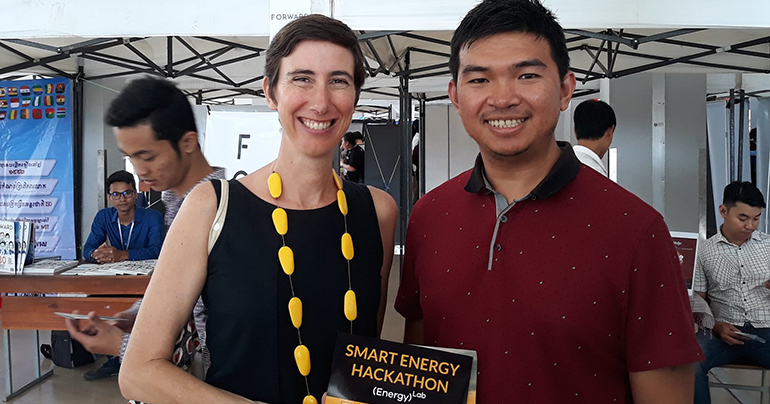EnergyLab Asia is an organisation that aims to facilitate the growth of the clean energy market in Cambodia, with a particular focus on startups and innovation. Southeast Asia Globe sits down with director of emerging markets Bridget McIntosh to discuss new technologies in renewable energy and the future of the sector in Cambodia

Tell me a little bit about what EnergyLab Asia does
We play a role in supporting the whole [clean energy] ecosystem here in Cambodia and act as a landing pad for international companies, to help facilitate their entry here. We have a coworking space so that entrepreneurs, startups, freelancers and [international businesses] can come and work with us, but also then we can introduce them to all the different companies that are already here, as well as [familiarising] them with government policy, institutions or development agencies in order to optimise the time that they are going to spend looking at Cambodia’s market.
We also do things like holding events to raise awareness of clean energy and to raise awareness of all the different technologies and opportunities that are happening worldwide. EnergyLab also works to stimulate startups and entrepreneurs to participate in the clean energy market in Cambodia. For example, we are holding a smart energy hackathon at the end of October. There is a two-fold intention behind that: one is to bring in people with ITC skills and expose them to what is happening in clean energy. Most ICT people think renewable energy is not interesting for them, but actually there is a lot that they can do that is related. The other objective is to see if we can support people who are interested in starting a new idea and then possibly help them connect with another person who is interested in exploring [a similar idea].
What new advancements have there been in renewable energy technology recently?
The clean energy market is so interesting at the moment because of the convergence of cheaper renewable energy – including solar – but also cheaper things like sensors, digitisation, communications, the Internet of Things and access to individual consumers. When you put all that together, it takes energy from being really boring – how the industry used to be – to how it is now. As a result of those [developments], there are a lot of chances for startups or businesses to create innovations that can be in the hands of consumers.
[InspireAsean2018]
So one example [of an advancement in technology] is around commercial buildings. Typically, commercial buildings use a lot of energy and they’re usually slow to react to what is happening inside and outside. But if you wire up a commercial building to be smart, so that you can monitor the air temperature outside, the humidity outside, the number of people in the building, and the number of people in all the segments of the building, and then you connect that with all the controls and sensors of valves, chillers, fans, and blowers, then you can establish how the building is performing compared to how it should be performing.
An example of a new innovative company is Village Energy. It is an Australian company that has come out of Horizon Power – which is one of Australia’s largest utility companies. [Village Energy] is about working with grid operators in developing countries to help them optimise their grid. For example, what they do is use artificial intelligence, machine learning and blockchain for the payment system, and have meters in all the houses and businesses within a certain part of the grid. Then they have controls on certain loads; for example, households can nominate which loads in their house they would be willing to lose if the power was looking like it was going to be cut and which loads in their house they definitely need to keep. And then [consumers] can say, for example, “I’m happy to lose the fridge for two hours, but I’m not happy to lose the fridge for 10 hours”. With the machine learning it then learns how it can distribute power across the grid more effectively to avoid blackouts and manage the voltage.

Have you noticed younger Cambodians taking more of an interest in renewable energy as an option?
We have been running an internship programme based out of Australia for the last four years – this year was the fifth year. So we have worked with 50 students at universities studying engineering or science, to offer them an opportunity to work at clean energy companies in Cambodia through an internship during their summer holidays. When we first came to involve the Institute of Technology Cambodia, they said “I don’t think anyone will be interested in working for a renewable energy company, they all want to work with big Thai and Chinese building developers and do the electrical work”. Anyway, [in the first year] we got seven applicants and last year, when we put it out we had 21 applicants. So it is growing. One of the reasons we are holding Clean Energy Week is that we realise how few people know what clean energy is. So why would they go and do an internship for a clean energy company when they don’t know what it is or why it would be interesting?
Cambodia’s energy demand is growing rapidly – almost 20% per year. Do you think Cambodia can keep up with these demands?
Cambodia still imports over 15% of its electricity from neighbouring countries, down from over 60% in 2010. There is new supply coming on line but large power stations take a long time to build. Solar is the only large-scale technology that can move quickly enough to fill the shortages. It’s possible to build a solar farm in six months, although of course it takes time to contract the sale and financing. But it certainly doesn’t take six, seven, or even eight years like a hydro dam or coal-fired power station. So actually, as demand increases, those increments can be by achieved with solar. And wind too, would be great.
It seems like it is not worth investing in coal right now?
Coal is already more expensive. Just based on pure economics, solar is more competitive than coal.
[manual_related_posts]
What’s the most exciting project that EnergyLab Asia has worked with in the last year?
I would definitely say Okra Solar. I think the advancement in technology for rural off-grid opportunities is massive. The smarts that they are developing are going to be so valuable to making sure that microgrids become a viable solution for off-grid households. Their technology allows people who have already invested in a solar home system to connect and optimise them.
My big concern about solar home systems is that they always limit a household to the amount of power that they have in that one system. But as [homeowners] develop economically, they should be able to buy another appliance, and that gets tricky [with solar home systems]. However, Okra allows the sharing of electricity by connecting these systems across a grid to manage the variations in who is doing what. Then the operator of that grid can see there needs to be more demand here or there, so [the operator] can invest in another solar panel. So the fact that it is scalable is a big difference. Before, solar home systems were limited.
How valuable is it for local or international companies to come together to discuss renewable energy on a regular basis?
I think networking and understanding what’s happening elsewhere in the industry is highly valuable. For example, I introduced two people: one who is working a lot in producing electronics and controls for large commercial buildings, and another who has a lot of experience in designing technology and understanding what is happening in smart commercial buildings. There is a perfect partnership between those two.
So meeting other people and sharing ideas and being open to what is happening is really valuable. At the end of the day, this industry is run by people, and so people coming together to learn and build business opportunities with each other is really valuable.
EnergyLab
Why now is an exciting time for Cambodia's clean energy market
EnergyLab Asia is an organisation that aims to facilitate the growth of the clean energy market in Cambodia, with a particular focus on startups and innovation. Southeast Asia Globe sits down with director of emerging markets Bridget McIntosh to discuss new technologies in renewable energy and the future of the sector in Cambodia

